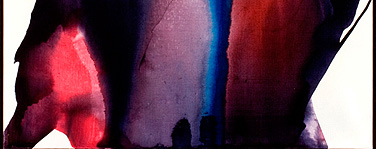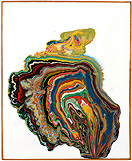News
�Under Each Other�s Spell� on view
in UB Anderson Gallery

Paul Jenkins, Phenomena Nightwood, 1962.
An exhibition in UB’s Anderson Gallery explores the fruitful relationship between Japan’s avant garde Gutari Art Group, founded in 1954 in Osaka, and some of New York’s most influential artists of the 1950s and ’60s, among them Jackson Pollock, Robert Rauchenberg and Jasper Johns.
“Under Each Other’s Spell”: The Gutai and New York” opened April 10 and will run through Aug. 22 in the gallery at One Martha Jackson Place, off Englewood Avenue between Main Street and Kenmore Avenue.
Exhibition guest curator Ming Tiampo, associate professor of art history at Carleton University, Ottawa, will give a lecture and tour of the exhibition at 7 p.m. May 13.
A graduate of Princeton University with a PhD from Northwestern University, Tiampo’s research, writing and lectures have focused on the Gutai Group and challenging Western-centric views of modernist history. Her most recent publication, “Gutai: Decentering Modernism” ( University of Chicago Press), will be available in Fall 2010.
The exhibition, which is free and open to the public, may be viewed from 11 a.m. to 5 p.m. Wednesday through Saturday and from 1-5 p.m. on Sunday. For information, call 829-3754.
The history of the Anderson Gallery and its collections is unusually pertinent to this exhibition. Martha Jackson, mother of David Anderson, was a famous and influential gallery owner in New York City until her death in 1969, and in 1958 introduced the Gutai to American audiences in an important exhibition.
Its manifesto defined Gutai as “truth to the material of which art is made” and the lifting of that material to spiritual heights. Group founder Jirō Yoshihara singled out Jackson Pollock and the French painter Georges Mathieu as artists who "grapple with the material in a way which is completely appropriate to it," and encouraged group members to emulate this approach. They promulgated their theories in the journal Gutai, which published 14 issues between 1955 and 1965.
Sandra Olsen, director of the UB Art Galleries, says the Gutai group was well aware of its distance from the art world's centers, and used the postal system extensively to build its international network. These efforts resulted in publication of some of Ray Johnson's earliest postal “moticos,” and the inclusion of Gutai in artist Allan Kaprow's 1966 book, “Assemblages, Environments and Happenings.”
Yoshihara collected art journals from around the world, and also sent copies of the Gutai journal to artists overseas, including Pollock, who loved them because they shared his vision and reality.
The exhibition draws in particular from the Pollock-Krasner House Collection, the Martha Jackson Archives of the Anderson Gallery, the David Anderson Collection and a group of paintings in the collection of painter Paul Jenkins
Jenkins was an artist in residence at the Gutai Pinacotheca (“pinacotheca” refers to a picture gallery in either ancient Greece or ancient Rome) in Osaka in 1964. The paintings in this exhibition by members of the Gutai group were given to Jenkins in exchange for his own works as an act of friendship. The exhibit takes its name from a comment by Jenkins that during the time he and the Gutai artists spent together, they were "under each other's spell."
The UB exhibit includes paintings by Gutai members Yoshihara, Atsuko Tanaka, Shōzō Shimamoto, Sadamasa Motonaga, Kazuo Shiraga and Akira Kanayama. It also features examples of the Gutai journal and other publications, works by New York artists who related strongly to Gutai, rare videos of Gutai exhibitions and performances in Japan, and photographs of American artists, including Jenkins, Robert Rauschenberg, Alice Baber, Jasper Johns and John Cage, visiting the Gutai group in 1964.
It will be accompanied by a fully illustrated catalogue, with essays on the interaction between Gutai and New York artists written by guest curator Tiampo, and on Pollock”s relationship to the Gutai group by Tetsuya Oshima, curator of the Aichi Prefectural Museum of Art in Japan.
The exhibition was organized by the Pollock-Krasner House and Study Center in East Hampton, where it was on view July 30 to Oct. 17, 2009, before traveling to the Harold B. Lemmerman Gallery of New Jersey City University and to UB.


Reader Comments